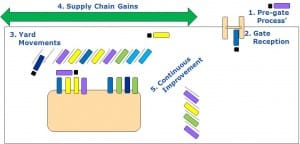Last August, there was an interesting article in the New York Times titled “Nordstrom Links Online Inventory to Real World.” While many retailers at the time were experiencing year-over year sales decreases at stores open for more than a year, sales at the high-end chain Nordstrom were actually improving and outperforming the department store average measured by Thomson Reuters.
Jamie Nordstrom, president of Nordstrom Direct, attributed the company’s success to improvements in its multichannel capabilities. Specifically, Nordstrom customers can now order an item online and pick it up at a nearby store. In the past year or so, Nordstrom’s same-store sales increased by an average of 8 percent. In the 11 months before the shift, sales had decreased by 11.9 percent.
Nordstrom improved its multichannel capabilities in part to improve customer service, something the retailer was already famous for. The number one request to its call center was whether a customer could go to a local store and shop for an item displayed on the company’s website. But the changes were also driven by a desire to increase sales. Mr. Nordstrom pointed to research showing that multichannel shoppers spend four times more, on average, than single-source shoppers do. Once you get an online shopper into the store, they are apt to buy more.
In order to support this change, Nordstrom had to aggregate its inventory across its network and make it visible. As highlighted in the article:
The change works this way: Say that a shopper was looking at a blue Marc Jacobs handbag at Nordstrom.com. She could see where it was available at nearby stores, and reserve it for pickup the same day. More significant, if the Web warehouse was out of that bag, it did not matter. Inventory from Nordstrom’s 115 regular stores is also included. Maybe there was just one handbag left in the entire company, sitting forlornly in the back of the Roosevelt Field store — it would be displayed online and store employees would ship it to the Web customer.
This change occurred in two stages. About two years ago, Nordstrom added the option for customers to shop and buy items online and pick them up at a store. In September 2009, the company started providing visibility to individual store inventory on its Web site.
As a supply chain analyst that closely follows the market, I’m willing to hazard an educated guess that Nordtsrom almost certainly implemented a Distributed Order Management (DOM) system as part of this change. Leading DOM suppliers include Sterling Commerce and Manhattan Associates (both ARC clients)
Why can’t an Enterprise Resource Planning (ERP) solution provide this level of inventory visibility? The problem is that ERP solutions lack the logic to track order fulfillment events from order to delivery and they lack intelligence to support the logistics of multichannel order fulfillment.
All DOMs bolt on to an ERP solution and add extra visibility and intelligence. DOMs have what I call “order parsing logic”–e.g., if the inventory to fulfill an order can come from multiple sources, which warehouse should it be shipped from? Sterling’s DOM, for example, can calculate order lead-times based on service level agreements, carrier pick up schedules, and warehouse or store processing times. The solution can also dynamically allocate customer orders based on priorities, such as channel or customer types, and it can configure payment types and pre-authorize payments even before the order is placed, which reduces the number of uncollectable payments.
So what were Nordstrom’s results? According to the NYT article, “The percentage of customers who bought merchandise after searching for an item on the site doubled on the first day, and has stayed there (although, Mr. Nordstrom cautioned, that doubling was from a small base).” Nordstrom did have to hire more shipping employees to wrap and ship items from each store, but the increased sales more than offset these costs.
Inventory turns have also improved, from 4.84 in 2005 to 5.41 in 2009 (a five year high). A nice side benefit has been fewer mark downs. “If we’re out of something on the Web site, it’s probably late in the season and the stores are trying to clear it out,” Mr. Nordtrom said.
In conclusion, the changes at Nordstrom were driven by a desire to satisfy customers, but it also translated into higher profits for the company.

















